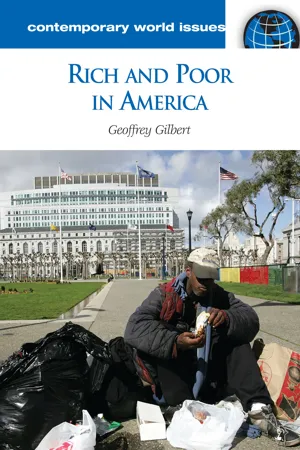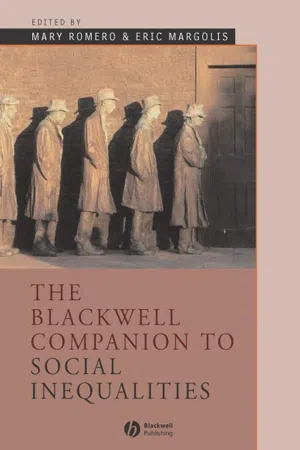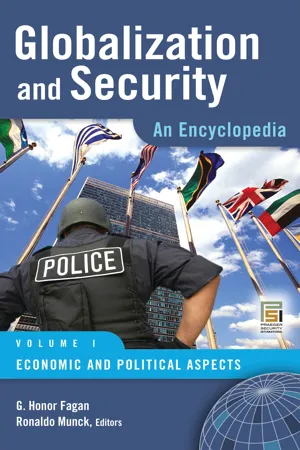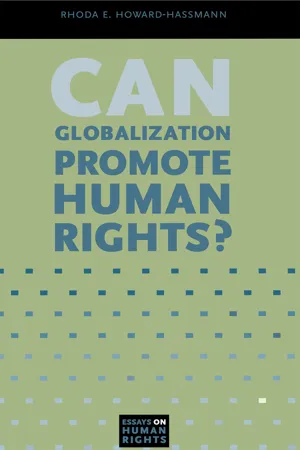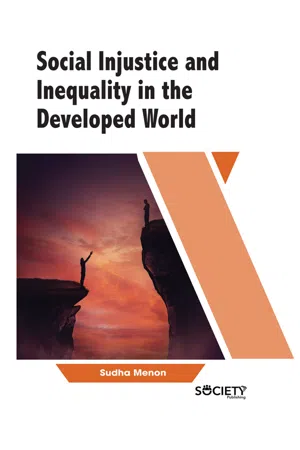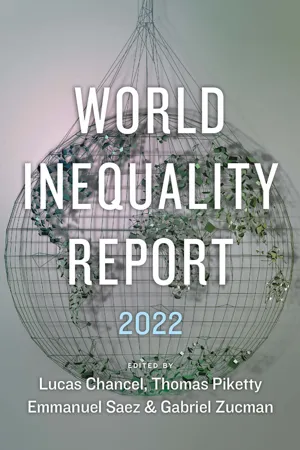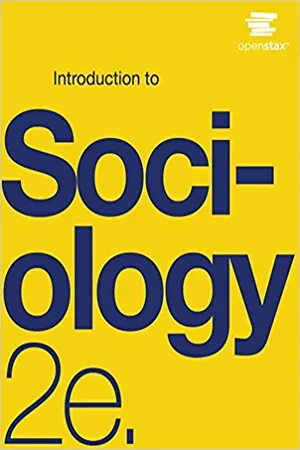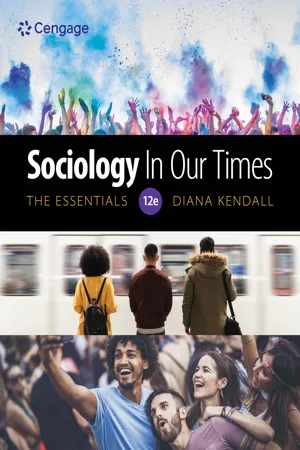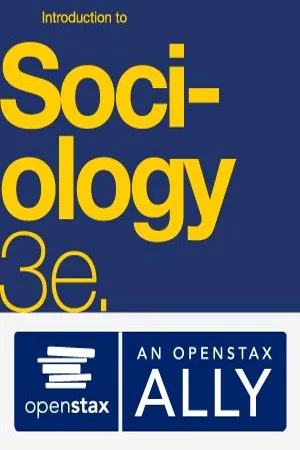Social Sciences
Global Inequality
Global inequality refers to the unequal distribution of resources, wealth, and opportunities among countries and individuals worldwide. It encompasses disparities in income, education, healthcare, and living standards, and is influenced by factors such as economic policies, trade agreements, and historical legacies. Addressing global inequality requires understanding its complex causes and implementing policies to promote greater equity and social justice on a global scale.
Written by Perlego with AI-assistance
Related key terms
1 of 5
12 Key excerpts on "Global Inequality"
- eBook - PDF
- Medani P. Bhandari, Shvindina Hanna(Authors)
- 2021(Publication Date)
- River Publishers(Publisher)
1 Chapter 1 Social Inequality as a Global Challenge: Scenario, Impacts, and Consequences Medani P. Bhandari, PhD 1 1. Introduction “ Inequality—the state of not being equal, especially in status, rights, and opportunities—is a concept very much at the heart of social justice theories. However, it is prone to confusion in public debate as it tends to mean different things to different people. Some distinctions are com-mon though. Many authors distinguish “economic inequality”, mostly meaning “income inequality”, “monetary inequality” or, more broadly, inequality in “living conditions”. Others further distinguish a rights-based, legalistic approach to inequality—inequality of rights and asso-ciated obligations (e.g. when people are not equal before the law, or when people have unequal political power )” (United Nation 2018:1). Inequality is one of the major human to human divisive factor since the evolutionary history of human development and civilizations. Inequalities present in every sphere of social, political, and economical structure of com-munity, national and international level throughout social, economic, reli-gious, and political histories. The strata created by inequalities are grounded 1 Professor of Sustainability, Akamai University, Hilo, Hawaii, USA; Prof. of Innovation and Finance, Sumy State University, Ukraine. [email protected] 2 Social Inequality as a Global Challenge on innumerable factors—such as social, cultural, political, geographical, or due to environmental (anthropogenic or natural) catastrophe. Inequality can be seen as a communicable global disease. Inequalities can be understood in many forms, however, mostly known, and discussed forms are economic, social, political, cultural, and religious inequalities. As Stewart (2010) notes: “Economic inequalities include access to and ownership of financial, human, natural resource-based and social assets. They also include inequalities in income levels and employment opportunities. - eBook - PDF
Rich and Poor in America
A Reference Handbook
- Geoffrey Gilbert(Author)
- 2008(Publication Date)
- ABC-CLIO(Publisher)
A split decision does not settle the issue, but an entirely new approach just might, and to that we now turn. A New Concept of Global Inequality We have considered two ways of measuring the divide between the world’s rich and poor: within-country inequality and between-country inequality. Income gaps within many countries, including the United States, have been growing for decades. In- come dispersion across countries, although far greater today than at the dawn of the industrial era, has begun to diminish during the past half-century, according to one index (the population- weighted Gini). So these two approaches give us mixed signals on the inequality trend. There is a third approach to the issue of global income inequality that has begun receiving attention in re- cent years. It involves treating everyone in the world as a “world citizen” rather than as a resident of any particular country. The world is reconceived as a borderless community of 6.7 billion in- dividuals. The idea is neatly conveyed in the title of Surjit Bhalla’s 2002 book, which helped inaugurate this new approach: Imagine There’s No Country: Poverty, Inequality, and Growth in the 92 Worldwide Perspective Era of Globalization. What Bhalla and others aim to do is gauge the extent of inequality across all of the world’s people, wherever they may live, and to determine whether the global trend is to- ward more equality or more inequality. Before we consider the specific findings of this third ap- proach, it is worth noting the policy relevance of the three ways of thinking about inequality. Country-level inequality is an impor- tant concern for those who design, analyze, and advocate for pol- icy changes within nations, whether in the area of taxation, income transfers, educational subsidies, or investment policies. - Mary Romero, Eric Margolis, Mary Romero, Eric Margolis(Authors)
- 2008(Publication Date)
- Wiley-Blackwell(Publisher)
Aver-ages, such as the Gini coefficient, do allow for comparisons but cannot capture the stark realities of inequality. There is now fairly widespread agreement that there are winners and losers in the global economy (see Kapstein 2000). There is also an understanding that a rising tide does not lift all boats, as it were. But apart from the methodological muddles referred to previously, there also is disagreement on “what is to be done.” From a World Bank perspective, Nancy Birdsall argues that, “not all inequality is a bad thing. Some inequality represents the healthy outcome of differences across individuals in ambition, motivation and willingness to work” (1999: 1). This “constructive” inequality – seen to be characteristic of “equal opportunities” societies – is contrasted with “negative” inequalities, such as access to land or new inequality paradigm for the era of globalization? 41 education in Latin America. The latter is beginning now to concern the multilateral-economic organizations that see its negative, long-term impact on economic growth and its role as a direct cause of social instability. From a socio-logical perspective, we might prefer to read inequality as an aspect of social exclu-sion, which conspires against any project for global justice. Social and Spatial Aspects Social exclusion often takes a spatial form, but it also is racialized, and gender divi-sions are central to its various manifestations. I propose to sketch in some current forms of social exclusion in the various parts of the world dubbed the global South, the North, and what was once the East – the former state-socialist countries. The East Asian “tiger economies” stand out as countries where social inequality actu-ally was reduced in the twentieth century’s last two decades. In the three main world regions identified, not only did social inequality increase, but so also did social polarization.- eBook - PDF
Globalization and Security
An Encyclopedia [2 volumes]
- G. Honor Fagan, Ronaldo Munck, G. Honor Fagan, Ronaldo Munck(Authors)
- 2009(Publication Date)
- Praeger(Publisher)
Finally, former European communist countries have retained the relatively equal distribution of wealth characteristic of communist countries. The aforementioned GINI coefficients also points to another aspect of stratifi- cation: polarization. According to Manuel Castells (2000), polarization refers to the deepening of the differences between the very wealthy and the very poor, 234 Social and Cultural Aspects with a shrinking global middle class squeezed in between. On a global scale, this refers to the widening gap not only between rich and poor countries but also within countries, between the top and bottom 10 percent, with the increas- ing pressure on the middle classes widely documented in the Western media. MEASURING GLOBAL INEQUALITIES: CONTROVERSIES To discuss global inequalities in the global context always brings up the issue of whether globalization increases or decreases global inequalities. Such an issue remains difficult and controversial because there is no agreement as to which are the best economic indicator of inequalities. A major proponent of the idea that economic globalization reduces inequalities is Glenn Firebaugh (2003). In his book The New Geography of Income Inequality, Firebaugh distinguishes between income inequality within countries and income inequality between coun- tries. Each type of inequality has dominated different historical periods: Thus, in phase 1, from the beginning of early Western industrialization until the end of World War II, increasing between-nation inequality was the dominant form. However, in phase 2, which started in the mid-twentieth century, that trend was reversed and domestic inequality came to predominate. In the global con- text, the spread of industrialization and technology has decreased the level of between-nation inequality, but within-nation inequality has increased (Xie 2005, 617). - eBook - PDF
- Rhoda E. Howard-Hassmann(Author)
- 2010(Publication Date)
- Penn State University Press(Publisher)
On the other hand, poverty has increased and inequality has widened within some countries. within-country inequality and poverty One way to ensure that individuals enjoy economic human rights is to redistribute wealth from the richest to the poorest. Yet, although world pov- erty levels decreased during globalization, within some countries inequal- ity widened. Among countries, the Gini coefficient ranges from about 0.2 to 0.7; inequality is generally wider in sub-Saharan Africa and Latin America and lower in Asia and the advanced Western industrial democra- cies. For example, in Canada the Gini coefficient was 0.321 in 2005, in the globalization, poverty, and inequality 27 United States it was 0.450 in 2007, in Brazil it was 0.567 in 2005, and in Namibia it was 0.707 in 2003 (Central Intelligence Agency 2008). The benefits of economic growth are less likely to reach the poor in countries with high inequality (Ravallion 2003, 21). High within-country inequality often indicates that the society is organized in such a way that it is difficult for the poorest to participate meaningfully; it may also be an indicator of poor development prospects. With little buying power, the poor are less able to contribute to a country’s economic growth, and with poor education and in bad health they are less likely to be employable in growth industries. High within-country inequality may also affect the political process. Demoralized by the contrast between their own living conditions and those of the rich, the poor may withdraw from the politi- cal process, rebel, or even turn to crime. Finally, high inequality implies that the poor do not enjoy the human dignity on which all human rights are premised. It suggests that their governments do not take the poorest citizens’ needs seriously enough to devote resources to them. - Sudha Menon(Author)
- 2020(Publication Date)
- Society Publishing(Publisher)
The factors such as income and asset distribution will be described so that the inequalities among people can be understood. At last, the chapter evaluates the issues of globalization persisting and enhancing the inequality among nations. 2.1. INTRODUCTION Social injustice practices still persist in the society in many forms. Various countries around the world have to deal with these issues on a daily basis. There are numerous cases of social injustice, discrimination, and inequality that are being filed in the developed countries and so many of these cases are not filed. The form of social inequality is of wide variety, these practices are being implemented in the areas of political, legal, and regulatory institutions. In the majority of cases of inequality, the rich and wealthy are at fault. They are responsible for different practices that lead to intimidation and corruption with different forms of influence. It is a clear fact that even the developed countries are suffering from higher inequality levels and instead of working in the direction of reducing these inequality practices, governing bodies of these countries are not fully considering this as an issue. This is resulting in growing this issue over time. The issue of social inequality has risen so much that it has become three times more than it was over a hundred years ago. This is due to the fact that the government is not fully aware of the issue and thus, they are not working in the direction of dealing with the issue of social inequality effectively. The living standard and quality of life of the people who are rich and the people with good education is always better than the poor and the illiterate.- eBook - PDF
- Lucas Chancel, Thomas Piketty, Emmanuel Saez, Gabriel Zucman, Lucas Chancel, Thomas Piketty, Emmanuel Saez, Gabriel Zucman(Authors)
- 2022(Publication Date)
- Belknap Press(Publisher)
CHAPTER 1 Global economic inequality: insights WORLD INEQUALITY REPORT 2022 19 What is the level of global economic inequality today? ............... 20 Global income and wealth inequality between individuals: initial insights ......................................................................................... 20 Global income and wealth inequality between countries.............. 22 Income inequality varies significantly across regions ..................... 24 Differences in inequality are not well explained by geographic or average income differences.................................. 27 The geographical repartition of global incomes .............................. 27 The limited impact of redistribution on Global Inequality ............ 28 The complementarity between predistribution and redistribution ........................................................................................ 31 The extreme concentration of capital ............................................... 32 Box 1.1 Income and wealth inequality concepts used in this report ................................................................................. 38 Box 1.2 The WID.world and Distributional National Accounts Project ........................................................................................... 38 Box 1.3 The rich ecosystem of Global Inequality data sets ................. 40 Box 1.4 Impact of the Covid crisis on inequality between countries ...................................................................... 42 Box 1.5 Impact of the Covid shock on inequality within countries ........................................................................... 42 Box 1.6 What is the relationship between Gross Domestic Product, National Income and National Wealth? .................................. 46 Box 1.7 Comparing incomes, assets and purchasing power across the globe .............................................................. 47 - eBook - PDF
- Heather Griffiths, Nathan Keirns, Eric Strayer, Susan Cody-Rydzewski, Gail Scaramuzzo, Tommy Sadler, Sally Vyain, Jeff Bry, Faye Jones(Authors)
- 2015(Publication Date)
- Openstax(Publisher)
Researchers try to understand Global Inequality by classifying it according to factors such as how industrialized a nation is, whether a country serves as a means of production or as an owner, and what income a nation produces. 10.2 Global Wealth and Poverty When looking at the world’s poor, we first have to define the difference between relative poverty, absolute poverty, and subjective poverty. While those in relative poverty might not have enough to live at their country’s standard of living, those in absolute poverty do not have, or barely have, basic necessities such as food. Subjective poverty has more to do with one’s perception of one’s situation. North America and Europe are home to fewer of the world’s poor than Africa, which has most poor countries, or Asia, which has the most people living in poverty. Poverty has numerous negative consequences, from increased crime rates to a detrimental impact on physical and mental health. 10.3 Theoretical Perspectives on Global Stratification Modernization theory and dependency theory are two of the most common lenses sociologists use when looking at the issues of Global Inequality. Modernization theory posits that countries go through evolutionary stages and that industrialization and improved technology are the keys to forward movement. Dependency theory, on the other hand, sees modernization theory as Eurocentric and patronizing. With this theory, Global Inequality is the result of core nations creating a cycle of dependence by exploiting resources and labor in peripheral and semi-peripheral countries. Section Quiz 10.1 Global Stratification and Classification 1. A sociologist who focuses on the way that multinational corporations headquartered in core nations exploit the local workers in their peripheral nation factories is using a _________ perspective to understand the global economy. - eBook - PDF
Reclaiming Social Policy
Globalization, Social Exclusion and New Poverty Reduction Strategies
- Kenneth A. Loparo, Arjan de Haan(Authors)
- 2007(Publication Date)
- Palgrave Macmillan(Publisher)
In many countries, and we will come back to this in Chapter 4, the social differences have been key to the social contract that underlies many of the public policies, and these policies in turn have changed the manifestation of these differences. This highlights the importance of looking beyond average trends in poverty reduction and inequalities. While there is firm cross-country evi- dence that the poor do, on average, benefit from economic growth, and that there may not be a systematic correlation between economic growth and inequality, focusing on existing and emerging disparities is important Globalization, Inequality and the Demise of the State? 39 and that the various forms of disparities overlap and mutually reinforce each other. In the case of Orissa, which had the highest level of poverty among India’s major states in 1999/2000, inter- state regional disparities are extremely high, and social group and (most) gender disparities higher than the Indian average. The quan- titative data reflect extreme disparities, and possible ‘log-jams of disadvantage’ for people in the tribal upland (in itself highly unequal) versus a coastal and higher caste elite. Long-standing inequalities in access to natural resources impact on disparities between social groups and gender relations (for example as a result of deforestation). The socio-economic disparities are reflected in highly unequal access to public policies and institutions, reflected, for example, in very inefficient implementation of centrally-sponsored schemes, including the special scheme for the ‘KBK region’, the poorest area in ‘tribal’ southern Orissa, and the much-criticized IFAD supported rural development programme. The region, while considered ‘remote’, is not disconnected from the global economy: continued and often violent disputes around mining and displacement sug- gests that globalization comes with many potential negative con- sequences, particularly in the poorest regions. - eBook - PDF
- Diana Kendall(Author)
- 2020(Publication Date)
- Cengage Learning EMEA(Publisher)
However, South Asia has the largest absolute number of mul- tidimensionally poor people, and many of them live in India (United Nations Human Development Programme, 2018). Poverty, food shortages, hunger, and rapidly growing populations are pressing problems for at least two billion people, most of them women and children living in a state of absolute poverty. Although more women around the globe have paid employment than in the past, more and more women are still finding themselves in poverty because of increases in single-person and single-parent households headed by women and the fact that low-wage work is often the only source of livelihood available to them. Human development research has reached a surprising conclusion: Economic growth and higher incomes in low- and medium-development nations are not always neces- sary to bring about improvements in health and education. According to the Human Development Report, technological improvements and changes in societal structure allow even poorer countries to bring about significant changes in health and education even without significant gains in income. Theories of Global Inequality Social scientists have developed a variety of theories that view the causes and consequences of Global Inequality. We now examine modernization theory, dependency theory, world sys- tems theory, and the new international division of labor theory. Development and Modernization Theory According to some social scientists, global wealth and pov- erty are linked to the level of industrialization and economic development in a given society. Although the process by which a nation industrializes may vary somewhat, industri- alization almost inevitably brings with it a higher standard of living and some degree of social mobility for individual participants in the society. Specifically, the traditional caste system becomes obsolete as industrialization progresses. - eBook - PDF
- Tonja R. Conerly, San Jacinto College, Kathleen Holmes, Northern Essex Community College, Asha Lal Tamang, North Hennepin Community College(Authors)
- 2021(Publication Date)
- Openstax(Publisher)
Someone applying this view to Global Inequality would probably focus on understanding the difference between what someone living in a core nation defines as poverty (relative poverty, defined as being unable to live the lifestyle of the average person in your country) and what someone living in a peripheral nation defines as poverty (extreme poverty, defined as being barely able, or unable, to afford basic necessities, such as food). Global Stratification While stratification in the United States refers to the unequal distribution of resources among individuals, global stratification refers to this unequal distribution among nations. There are two dimensions to this stratification: gaps between nations and gaps within nations. When it comes to Global Inequality, both economic inequality and social inequality may concentrate the burden of poverty among certain segments of the earth’s population (Myrdal 1970). As mentioned earlier, one way to evaluate stratification is to consider how many people are living in poverty, and particularly extreme poverty, which is often defined as needing to survive on less than $1.90 per day. Fortunately, until the COVID-19 pandemic impacted economies in 2020, the extreme poverty rate had been on a 20-year decline. In 2015, 10.1 percent of the world's population was living in extreme poverty; in 2017, that 10.1 • Global Stratification and Classification 265 number had dropped an entire percentage point to 9.2 percent. While a positive, that 9.2 percent is equivalent to 689 million people living on less than $1.90 a day. The same year, 24.1 percent of the world lived on less than $3.20 per day and 43.6 percent on less than $5.50 per day in 2017 (World Bank 2020). The table below makes the differences in poverty very clear. - eBook - PDF
Development Economics
Theory and Practice
- Alain de Janvry, Elisabeth Sadoulet(Authors)
- 2021(Publication Date)
- Routledge(Publisher)
INEQUALITY AND INEQUITY 188 | REFERENCES Acemoglu, Daron, Simon Johnson, and James Robinson. 2002. “Reversal of Fortune: Geography and Institutions in the Making of the Modern World Income Distribution.” Quarterly Journal of Economics 117(4): 1231–94. Adams, Richard. 1991. The Effects of International Remittances on Poverty, Inequality, and Development in Rural Egypt. Research Report No. 86. Washington, DC: International Food Policy Research Institute. Adelman, Irma, and Sherman Robinson. 1978. Income Distribution Policy in Developing Countries: A Case Study of Korea. Stanford: Stanford University Press. Ahluwalia, Montek. 1976. “Inequality, Poverty, and Development.” Journal of Development Economics 3(4): 307–42. Alvaredo, Facundo, Lucas Chancel, Thomas Piketty, Emmanuel Saez, and Gabriel Zucman (eds.). 2018. World Inequality Report 2018. Cambridge, MA: The Belknap Press. Arbatli, Cemal, Quamrul Ashraf, and Oded Galor. 2013. The Nature of Civil Conflict. Working Paper No. 2013-15. Department of Economics, Brown University. Ashraf, Quamrul, and Oded Galor. 2013. “The Out of Africa Hypothesis, Human Genetic Diversity, and Comparative Economic Development.” American Economic Review 103: 1–46. Ashraf, Quamrul, Oded Galor, and Marc Klemp. 2014. The Out of Africa Hypothesis of Comparative Development Reflected in Nighttime Light Intensity. Working Paper No. 2014-4. Department of Economics, Brown University. Banerjee, Abhijit, and Esther Duflo. 2003. “Inequality and Growth: What Can the Data Say?” Journal of Economic Growth 8(3): 267–99. Barro, Robert. 2000. “Inequality and Growth in a Panel of Countries.” Journal of Economic Growth 5(1): 5–32. Bernard, Tanguy, Alain de Janvry, and Elisabeth Sadoulet. 2010. “When Does Community Conservatism Constrain Village Organizations?” Economic Development and Cultural Change 58(4): 609–41. Bourguignon, François. 2003. “The Growth Elasticity of Poverty Reduction: Explaining Heterogeneity across Countries and Time Periods.” In T.
Index pages curate the most relevant extracts from our library of academic textbooks. They’ve been created using an in-house natural language model (NLM), each adding context and meaning to key research topics.

